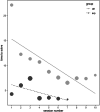Ratcheting up tool innovation in Goffin's cockatoos (Cacatua goffiniana): The effect of contextually diverse prior experience
- PMID: 37082334
- PMCID: PMC10108129
- DOI: 10.1111/eth.13351
Ratcheting up tool innovation in Goffin's cockatoos (Cacatua goffiniana): The effect of contextually diverse prior experience
Abstract
The ability to gain information from one situation, acquire new skills and/or perfect existing ones, and subsequently apply them to a new situation is a key element in behavioural flexibility and a hallmark of innovation. A flexible agent is expected to store these skills and apply them to contexts different from that in which learning occurred. Goffin's cockatoos (Cacatua goffiniana) are highly innovative parrots renowned for their problem-solving and tool-using skills and are thus excellent candidates to study this phenomenon. We hypothesized that birds allowed to use a tool in a larger variety of contingencies would acquire a broader expertise in handling it, facilitating its transfer to new tasks. In our study, we compared the performance of two groups of captive Goffin's cockatoos (N = 13): A test group received more diverse learning and motor experiences on multiple applications of a hook-type tool, while a control group received intensive, total trial-matched, experience with a single application of the same tool. Then, both groups were tested on two novel tasks to determine whether experience with the tool in multiple contexts would facilitate performance during transfer. While both groups transferred to both novel tasks, group differences in performance were apparent, particularly in the second transfer task, where test birds achieved a higher success rate and reached criteria within fewer trials than control birds. These results provide support for the prediction that experiencing a diverse range of contingencies with a tool appears to allow birds to acquire generalizable knowledge and transferrable skills to tackle an untrained problem more efficiently. In contrast, intensive experience with the tool in a single context might have made control birds less flexible and more fixated on previously learned tool-dependent instances.
Keywords: behavioural flexibility; parrot cognition; problem‐solving; tool use transfer.
© 2022 The Authors. Ethology published by Wiley‐VCH GmbH.
Conflict of interest statement
The authors declare no potential conflicts of interest with respect to the research, authorship and/or publication of this article.
Figures




References
-
- Anderson, J. R. (1976). Language, memory, and thought. Erlbaum.
-
- Auersperg, A. M. I. (2015). Exploration technique and technical innovations in corvids and parrots. In Kaufman A. B. & Kaufman J. C. (Eds.), Animal creativity and innovation (pp. 45–63). Academic Press.
-
- Auersperg, A. M. I. , Köck, C. , Pledermann, A. , O'Hara, M. , & Huber, L. (2017). Safekeeping of tools in Goffin's cockatoos, Cacatua goffiniana . Animal Behaviour, 128, 125–133. 10.1016/j.anbehav.2017.04.010 - DOI
Grants and funding
LinkOut - more resources
Full Text Sources
